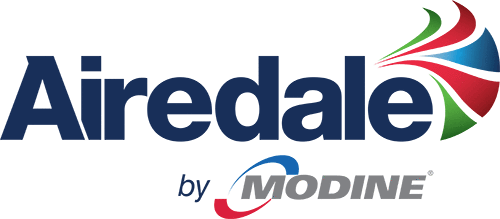Strategies To Maximize Cooling Efficiency
Cooling accounts for a significant share of data center energy use. Even modest efficiency improvements can lead to meaningful reductions in OPEX and carbon output. While IT hardware is advancing rapidly, cooling strategies often fall behind, hampered by legacy systems, siloed decision-making, and outdated assumptions.
Airedale by Modine sees cooling efficiency as a system-level discipline, beginning with thoughtful design and continuing into day-to-day operation. This approach focuses on how components interact, systems scale with demand, and control strategies evolve over time. True efficiency results from aligning infrastructure, intelligence, and intent.
Assessing the Efficiency Baseline
Before you can improve, you need to know where you’re starting. In cooling, that means looking beyond utility bills and into the granular data that tells the full story.
Power Usage Effectiveness (PUE) is the go-to metric, but it doesn’t stand alone. Water Usage Effectiveness (WUE), thermal compliance rates, and return air temperatures all contribute to the performance picture.
Thorough audits help uncover system-level performance. CFD modeling can pinpoint areas of thermal imbalance, while controls data shows how equipment responds under varying loads. These tools highlight inefficiencies that often go unnoticed, such as bypass airflow, oversized systems idling at partial load, improperly tuned setpoints, or equipment that isn’t working together as intended.
Skipping audits leads to treating symptoms rather than fixing root causes.
Right-Sizing and Zoning for Load Dynamics
Cooling systems built for worst-case scenarios rarely operate at their best. Designing around peak load conditions often leads to chronic inefficiency, with oversized equipment running far below optimal capacity. This results in wasted energy, inconsistent performance, and poor alignment between IT demand and cooling supply.
A smarter approach starts with understanding actual load patterns. Dynamic load profiling tracks how heat output shifts across racks and over time. With this insight, you can move away from blanket strategies and toward targeted solutions.
Zone-based design also plays a key role. Separating high-density and low-density zones allows your facility to match cooling strategies to actual needs. Instead of overcooling entire rooms, your systems can focus airflow, chilled water, or refrigerant where it’s truly required.
Airedale systems are built with zoning flexibility in mind. Whether the site calls for precision in-row delivery or broader perimeter cooling, the underlying architecture supports scale, control, and adaptability, without the energy overhead of overprovisioning.
Leveraging Modular and Scalable Cooling Systems
Growth is good, until your infrastructure can’t keep up. Cooling systems that scale with IT demand give operators a critical edge, especially in environments where capacity needs shift quickly and unpredictably.
Modular solutions eliminate the assumptions. Rather than locking into oversized central plants or retrofitting around fixed systems, you can deploy capacity in phases. Containerized cooling systems, in-row and in-rack units, and modular chilled water or DX plants enable just-in-time expansion without disrupting existing operations.
This kind of flexibility impacts efficiency directly. Systems that align with actual load avoid the energy waste of idle capacity and the performance degradation that overburdened equipment can cause.
Airedale offers a range of modular systems designed for rapid deployment and long-term agility. These solutions help future-proof your facility so you can scale up (or down) without a full system overhaul or the typical energy use spike.
Optimizing Airflow Management
You can spec the highest-efficiency cooling equipment on the market, but if you don’t manage airflow, performance falls apart. Physics doesn’tcare about your new system. Hot and cold air will mix, bypass will sneak through, and the result is higher energy use for less effective cooling.
That’s why you need good containment strategies. Hot aisle, cold aisle, or chimney-style setups all have the same goal: to separate hot return air from cold supply air as cleanly as possible. When containment is airtight and consistent, cooling becomes more predictable and much more efficient.
Don’t underestimate the importance of small but powerful tools. Blanking panels fill in gaps and keep cold air from escaping into empty rack spaces. Floor grommets seal around cable cutouts to keep air moving vertically rather than bleeding into underfloor chaos. Baffles redirect airflow where it’s needed and block it off where it’s not.
Advanced Controls and Intelligent Optimization
Cooling efficiency depends on system adaptability. Smart controls let your facility respond in real time and adjust performance based on constantly changing conditions.
Sensors monitor key metrics like server inlet temperatures, return air conditions, humidity, and pressure differentials. This data feeds directly into control platforms that can adjust fan speeds, modulate valves, and precisely cycle compressors. The result is tighter alignment between cooling output and IT load without relying on manual intervention.
Optimization platforms like Airedale’s build on this by analyzing historical patterns and forecasting demand. Some platforms use AI to refine their strategies over time and shift system behavior to reduce waste and improve thermal consistency. These tools identify patterns a human operator might miss and apply changes before problems arise.
Integrating Free Cooling and Heat Reuse
Mechanical cooling carries a cost. Whenever the climate or facility design allows, you should take advantage of opportunities to reduce or redirect that load.
Economizers are the obvious starting point. Air-side systems work well in cooler climates with clean ambient air, while water-side options fit better where humidity or air quality complicates direct exchange. The right choice depends on location, seasonality, and existing cooling infrastructure configuration.
Beyond free cooling, heat reuse is gaining traction, especially in regions with set decarbonization goals. Recovered heat can support district heating networks, supplement on-site water heating, or power absorption chillers for additional cooling capacity. Each application requires planning, but the payoffs are growing, both in energy savings and regulatory incentives.
Designing for Maintainability Without Efficiency Loss
The best cooling system in the world won’t stay efficient if no one wants to service it. Complex maintenance procedures, difficult access points, and systems that require downtime for basic upkeep all chip away at long-term performance.
Efficiency and maintainability go hand in hand. Filters should be easy to reach and replace. Coil surfaces should be accessible for regular cleaning. Controls interfaces must give technicians necessary data without a maze of menus or conjecture. When maintenance is straightforward, it’s easier to perform consistently, thoroughly, and on schedule.
At Airedale, we design our systems with this reality in mind. Our units include features like front-facing service access, built-in diagnostics, and integration with predictive maintenance tools. These design choices reduce service time and minimize the risk of undetected issues degrading performance over time.
Collaborating Early To Avoid Inefficiency Later
Some of the most persistent inefficiencies in cooling systems can be traced back to early design decisions. When mechanical, IT, and controls teams work separately, you get misalignments: overbuilt capacity, conflicting airflow patterns, and inconsistent or rushed control logic. Retrofitting to fix those issues later costs time, money, and performance.
True efficiency starts during planning. With early collaboration, you can keep your mechanical, IT, and controls teams working toward the same operational goals. It opens the door to smarter decisions around zoning, load balancing, and controls integration, decisions that are much harder to retrofit once the system is live.
We work directly with clients during early-stage design to help build systems that perform as intended. Our industry experience and technical guidance allow you to balance compliance, performance, and operational flexibility. By approaching design as a holistic process, Airedale by Modine helps your facility reduce inefficiencies that could become permanent fixtures once your
facility goes live.
Conclusion: Efficiency as a Competitive Advantage
Cooling efficiency used to be about saving money on energy bills. That’s still part of it — but now the stakes are higher. Energy use affects ESG targets, compliance metrics, uptime guarantees, and public perception. Facilities that prioritize smart, scalable cooling are better positioned to meet both operational demands and regulatory expectations.
Every choice, from equipment selection to airflow management to control strategy, matters. Efficiency is a system-level discipline that rewards consistency, foresight, and flexibility.
That’s the mindset with which Airedale by Modine approaches cooling. Our solutions are designed to work together across your facility’s full lifecycle, supporting measurable gains without compromising reliability. If your data center is under pressure to do more with less, it
may be time to rethink your old strategies and partner with experts who know where the hidden ROI is waiting.[/vc_column_text][/vc_column][/vc_row]





